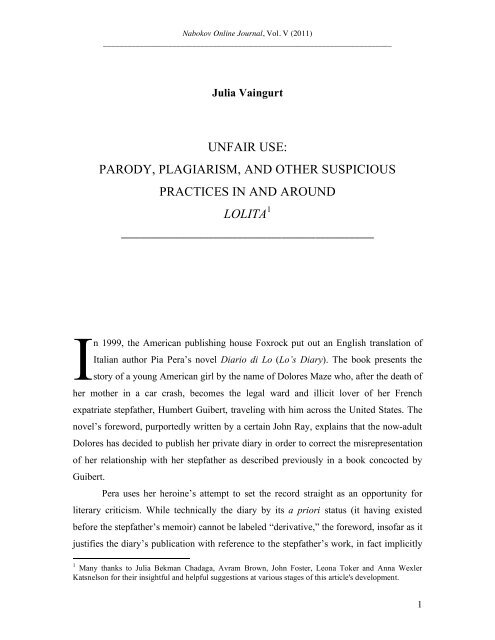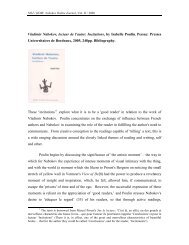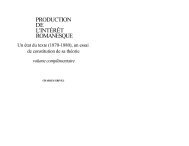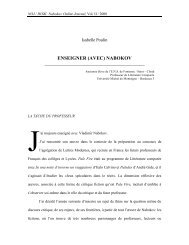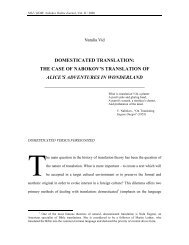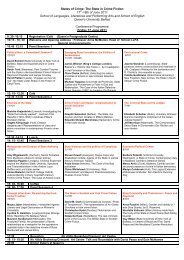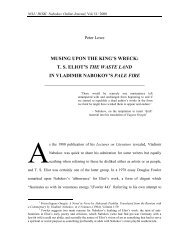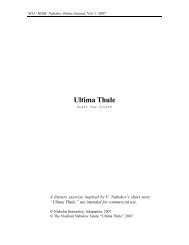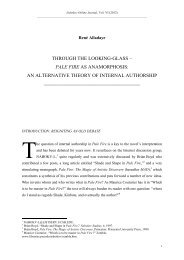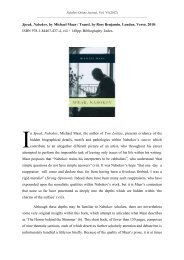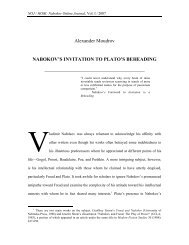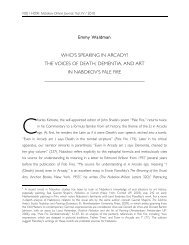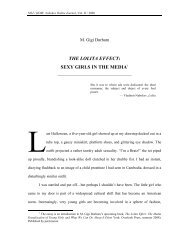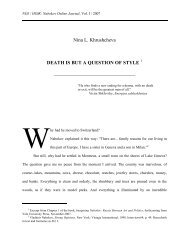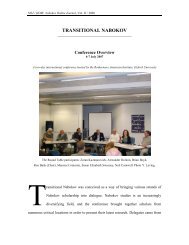You also want an ePaper? Increase the reach of your titles
YUMPU automatically turns print PDFs into web optimized ePapers that Google loves.
Nabokov Online Journal, Vol. V (2011)<br />
_______________________________________________________________________<br />
Julia Vaingurt<br />
UNFAIR USE:<br />
PARODY, PLAGIARISM, AND OTHER SUSPICIOUS<br />
PRACTICES IN AND AROUND<br />
LOLITA 1<br />
____________________________________________________<br />
I<br />
n 1999, the American publishing house Foxrock put out an English translation of<br />
Italian author Pia Pera’s novel Diario di Lo (Lo’s Diary). The book presents the<br />
story of a young American girl by the name of Dolores Maze who, after the death of<br />
her mother in a car crash, becomes the legal ward and illicit lover of her French<br />
expatriate stepfather, Humbert Guibert, traveling with him across the United States. The<br />
novel’s foreword, purportedly written by a certain John Ray, explains that the now-adult<br />
Dolores has decided to publish her private diary in order to correct the misrepresentation<br />
of her relationship with her stepfather as described previously in a book concocted by<br />
Guibert.<br />
Pera uses her heroine’s attempt to set the record straight as an opportunity for<br />
literary criticism. While technically the diary by its a priori status (it having existed<br />
before the stepfather’s memoir) cannot be labeled “derivative,” the foreword, insofar as it<br />
justifies the diary’s publication with reference to the stepfather’s work, in fact implicitly<br />
1 Many thanks to Julia Bekman Chadaga, Avram Brown, John Foster, Leona Toker and Anna Wexler<br />
Katsnelson for their insightful and helpful suggestions at various stages of this article's development.<br />
1
Nabokov Online Journal, Vol. V (2011)<br />
_______________________________________________________________________<br />
allows that it can. The structural irony of the diary’s existence complicates the<br />
relationship between the two texts.<br />
The act of keeping the diary is a rebellious gesture; it is an attempt to gain some<br />
form of agency, even co-authorship, over the events it narrates, thus shaking the authority<br />
of the stepfather’s text and changing the reader’s view thereof. For the diary’s publication<br />
to fulfill its aim, then, it has to be read alongside the original rendition of events, starkly<br />
affirming its parodic status; the word “parody” is derived from the combination of the<br />
Greek para, “alongside,” and oide, “song.” According to Russian Formalist Iurii<br />
Tynyanov, parody performs a dual function: it imitates and transforms (104). Without<br />
knowledge of the original text, the reader of the diary would be unable to appreciate its<br />
transformative, parodic purpose.<br />
In the English translation of Diario di Lo, however, the foreword of the fictional<br />
John Ray is preceded by another, in this case attributable to an actual person – Dmitri<br />
Nabokov, the son of Vladimir Nabokov, who wrote the original novel alluded to in the<br />
body of the Italian text and whose estate owns the copyright thereto. In his foreword,<br />
Dmitri Nabokov questions the transformative purpose of Lo’s Diary and claims that the<br />
novel constitutes an act of piracy, plundering and devaluing his father’s original work.<br />
Nabokov thus evinces the view that the author of the derivative work should have<br />
recompensed his father’s estate monetarily for the aesthetic value that it diminishes in the<br />
original. The foreword is provided for by a settlement clause in the agreement reached<br />
between Dmitri Nabokov and Barney Rossett, the owner of Foxrock Books. That Rossett<br />
also happens to have formerly headed Grove Press is perhaps ironic, insofar as Grove<br />
sought the rights to publish the first American edition of Vladimir Nabokov’s Lolita in<br />
1955, when many other publishers refused to take on such a controversial book. 2 With<br />
Lo’s Diary, Rossett had once again stepped up to the plate to champion another<br />
contentious literary work, in this case after its would-be English-language publishers<br />
(Farrar, Straus & Giroux in the U.S., and Macmillan in the U.K.) had backed out of their<br />
contracts with Pia Pera upon being sued by Dmitri Nabokov, who accused them of<br />
plagiarism and copyright infringement.<br />
2 Grove was unsuccessful in this attempt, and the first American edition was published by Putnam the same<br />
year.<br />
2
Nabokov Online Journal, Vol. V (2011)<br />
_______________________________________________________________________<br />
This high-profile literary affair provoked a great deal of publicity, but seemingly<br />
little comment or analysis in literary scholarship. Meanwhile, the lawsuit, and the<br />
foreword from which it results, beg a number of fascinating questions: can a literary<br />
character be in someone’s sole possession? After all, Lo’s Diary is an example of what<br />
Alastair Fowler calls the “elaborative type,” a work that “exploit[s] the fictive world of<br />
some great or popular predecessor” – a “numerous type, for there are hundreds of<br />
Robinson Crusoes and Gullivers; scores of elaborations of the Hamlet world; many Alices<br />
… Huck Finns and Jane Eyres” (127); does the mere existence of a living, litigious<br />
copyright holder spell a lawsuit for an “elaboration,” or might a particular ideological<br />
challenge to its source help the “elaboration” earn this distinction? Why, for that matter,<br />
is the retelling of content (in this case, plot details) considered derivative, but the copying<br />
(imitation) of style – undoubtedly a feature of Vladimir Nabokov’s own prose, and that of<br />
authors he valued most highly – parodic 3 and hence permissible, even praiseworthy? But<br />
if we defend Pera’s work as parody 4 , placing it under the protective umbrella of fair use,<br />
what risks do we incur? Can parody be, in fact, a crime? Does it undermine the right of<br />
an author to his/her own fictional space? Does parody, in reevaluating a work, reduce its<br />
aesthetic value? (Or, paradoxically, increase it?) And what, ultimately, is aesthetic value,<br />
and how is it measured in modernist and postmodernist practices? To the discussion of<br />
the unstable positioning of Nabokov’s texts on the border between modernist and<br />
3 In the story “Granita,” another Italian, Umberto Eco, painstakingly, provocatively, and recognizably<br />
replicates the mannerisms of Nabokov’s prose in Lolita, yet no one accuses him of theft; while Pera,<br />
pursuing her own literary agenda, replicates the details of Nabokov’s plot, only to find herself entangled in<br />
a lawsuit. Moreover, Michael Maar has recently suggested that Nabokov might have taken up rudimentary<br />
plot elements from Heinz von Lichberg’s short story “Lolita” (Berlin, 1916), a possibility complicating<br />
issues of origin and intellectual property still further. Maar concludes that such a borrowing of plot details<br />
on Nabokov’s part is an instance neither of plagiarism nor cryptoamnesia, but rather of modernist<br />
playfulness or, as Thomas Mann put it, “higher cribbing” (Maar 58).<br />
4 Martin Garbus, an attorney representing Foxrock, decided not to go that route, specifically indicating in<br />
an article on the case that “Lo’s Diary is not a parody or criticism.” My attempt to contact Mr. Garbus to<br />
ask about the legal reasoning behind this conclusion was unsuccessful. Leaving aside the law, however,<br />
Lo’s Diary is unquestionably a parodic work as the concept is understood in literary scholarship, satisfying<br />
as it does the three defining criteria outlined by Gary Saul Morson: “(1) It must evoke or indicate another<br />
utterance, which I will allude to henceforth as its ‘target,’ ‘object,’ or the ‘original utterance’; (2) it must<br />
be, in some respect, antithetical to its target; and (3) the fact that it is intended by its author to have higher<br />
semantic authority than the original must be clear” (110). The fulfillment of the first two criteria is evident<br />
in my short summary of the fictional preface to Lo’s Diary; I will discuss how Pera’s work satisfies the<br />
third criterion later in this essay.<br />
3
Nabokov Online Journal, Vol. V (2011)<br />
_______________________________________________________________________<br />
postmodernist strategies, this paper will add the analysis of Pera’s novel as a postmodern<br />
critique of the modernist aestheticism that, it might be argued, Nabokov’s text espouses.<br />
Remarkably, Nabokov fils’s foreword, beyond expressing his aversion to the<br />
existence of Pera’s novel, serves another important function: it forces upon Pera his<br />
permission for publication, which in fact she had never requested. Nabokov thereby both<br />
rejects and adopts the dreaded Lo’s Diary, 5 contributing to the expansion of the<br />
intertextual space initiated by his father’s Lolita and engaged by Pera’s text. I will argue<br />
here Dmitri Nabokov’s initiation of a lawsuit against Pera’s book in reality constitutes a<br />
shrewd attempt on the plaintiff’s part to have the last word in Pera’s debate with Vladimir<br />
Nabokov’s Lolita on the ethical value of aesthetics. While ostensibly enforcing the<br />
containment of Lolita within the limits delineated by its author, the author’s son de facto<br />
facilitated an even further explosion of Nabokov’s themes and characters beyond the<br />
borders of the novel into extratextual space – the sort of spill-over Nabokov’s<br />
controversial book has tended to produce. I am interested in this paper not so much in<br />
Lolita itself, but its afterlife. While there may have been, arguably, more successful<br />
attempts at parodying Nabokov’s novel 6 , it is the author of Lo’s Diary that found herself<br />
in a peculiar debate with another reader of Lolita, the debate that had some “real-life”<br />
ramifications. It could be noted that Lolita has had other non-literary aftereffects, such as<br />
the proliferation of “Lolita”-themed pornography, or the incorrect attribution of this name<br />
to a hypothetical over-sexualized child seductress. But it is in the case of Nabokov v.<br />
Pera, I would argue, that the novel’s central aesthetic issues, the existence of bad taste<br />
5 This act of appropriation is further underscored by the novel’s convoluted copyright page, which lists the<br />
copyright holders of the Italian-language original, its English translation, and Vladimir Nabokov’s Lolita,<br />
informing the reader moreover that “[t]his edition of Lo’s Diary is published by arrangement with the<br />
Estate of Vladimir Nabokov.” The copyright page of the Russian edition of Pera's book (made from the<br />
English translation and in arrangement with the Nabokov Estate) is even more surprising, as it<br />
acknowledges Dmitri Nabokov’s foreword, while the volume itself strangely omits it. I am grateful to Yuri<br />
Leving for bringing this curiosity to my attention.<br />
6 The same year that Pera’s book was published in English saw the appearance of Emily Prager’s Roger<br />
Fishbite, a remarkably funny novel about a twelve-year-old girl’s relationship with her pedophilic<br />
stepfather told from the girl’s point of view. At the end of the text Prager states that her novel is a parody<br />
both of Lolita the book and Lolita the phenomenon. Less clearly parodic, but with some recognizable<br />
allusions to Lolita, is A. M. Holmes’s horrific The End of Alice.<br />
4
Nabokov Online Journal, Vol. V (2011)<br />
_______________________________________________________________________<br />
and its relationship to crime and law, left the parameters of strictly literary debate and<br />
revealed extratextual consequences. 7<br />
PARODY, PECCANCY, AND PECCADILLO IN LOLITA<br />
In Nabokov’s Lolita, questions of parody, crime, and aesthetic value are curiously<br />
entangled. Numerous critics have discussed the meta-literary character of the novel. 8<br />
Some have noted that despite Nabokov’s own emphasis on aesthetic bliss as the only<br />
ultimate purpose of his creative work, the novel is by no means devoid of ethical<br />
considerations, thematizing and exploring as it does the relationship between the ethical<br />
and the aesthetic. One of the ways to approach this relationship in Nabokov is to suggest,<br />
as does Richard Rorty in “The Barber of Kasbeam: Nabokov on Cruelty,” that in his<br />
novels Nabokov explores his fear of cruelty by probing the capacity of art to overcome it.<br />
Examining Humbert’s cruel incuriosity, specifically in the episode in which the<br />
eponymous barber tells the uninterested Humbert about his dead son, Rorty argues that<br />
Nabokov exorcises his fear that art might not necessarily involve empathy by creating<br />
aloof artists whose autonomy/originality precludes compassion (148). A similar argument<br />
is made by David Rampton, who in his study of Lolita states that “Humbert’s description<br />
of Lolita at tennis is an exercise in the special art of seeing her as an object, an art that<br />
only aesthetic detachment makes possible. And his ‘Confession,’ the product of that<br />
detachment, is at the same time a study of its limitations” (116). In conjunction with these<br />
interpretations, a key observation of Ellen Pifer – that “[c]areful attention to the text [of<br />
Lolita] reveals the ways in which it is designed to reveal what the narrator attempts to<br />
conceal, or blindly ignores” (187) – might suggest that Humbert, while deficient as a<br />
7 Approaching the issue from a legalistic point of view, a recent article by David Roh “Two Copyright Case<br />
Studies from a Literary Perspective” argues the opposite. In my opinion the consequence of Nabokov’s<br />
very public lawsuit and no less emphatic foreword is a broadening of the boundaries of the literary<br />
dialogue; David Roh, however, reads the copyright dispute, despite Pera’s ostensible victory, as a potential<br />
agent of suppression in the process of literary evolution. Such highly publicized cases of copyright<br />
disputes, Roh asserts, will make publishers avoid appropriative works, thereby squelching potentially<br />
fruitful literary and ideological debates.<br />
8 On Nabokov’s parodic method and aims in Lolita, see the studies of, among others, Alfred Appel, Jr.,<br />
Thomas R. Frosch, Brian Walter, and Julia Bader.<br />
5
Nabokov Online Journal, Vol. V (2011)<br />
_______________________________________________________________________<br />
human being, is not in fact compromised as an artist, because despite his authorial<br />
intentions he has created a text that, just like Dolores Haze, resists authorial control and is<br />
both aesthetically and ethically whole. 9 While I find these readings compelling, my own<br />
interpretation sides not so much with the discernment of a compromise in the novel’s<br />
very fabric of the author’s own vision of ethical aesthetics as with the view of Humbert’s<br />
art as lacking. Leland de la Durantaye, for example, reads Lolita as an examination of the<br />
artist’s relationship to his art and to external reality, noting that while Humbert possesses<br />
a “spinal sensitivity,” a faculty Nabokov considered indispensable in an artist, he lacks<br />
empathy. This lack ensures that Humbert subjects external reality, and specifically Lolita,<br />
to his aesthetic will, reducing her from ethical subject to object of aesthetic<br />
contemplation: “Instead of giving life to art, Humbert treats life as art, and the moral<br />
message of the work appears to be that this error is a deadly one” (de la Durantaye,<br />
“Lolita in Lolita” 191). Thomas Frosch proposes that “what is on trial [in Lolita] is<br />
Humbert’s uniqueness and originality, his success in an imaginative enterprise” (179); in<br />
Frosch’s persuasive reading, Humbert is a failed poet.<br />
Humbert’s plight, then, is that of an aesthete forced in the process of writing to<br />
experience doubt in his aesthetic discernment, to confront, and try to overcome, his<br />
inability to produce original art due to certain stilted views, habits, and vision-dimming<br />
obsessions. Nabokov’s oeuvre in general interrogates the view that in choosing<br />
multifarious, mysterious life as a subject of art, a true artist does not force it to serve his<br />
base needs, but attempts to immortalize it in all its complex vitality. 10 In “Lolita: The<br />
Springboard of Parody,” Alfred Appel Jr. notes that “the attempt to transcend solipsism is<br />
one of Nabokov’s major themes” (205). Authorship entails communication with one’s<br />
subject, the subjection of one’s purpose to the needs of the material, indeed, to serve the<br />
material; one of Humbert’s last lines directed to Lolita reads: “[O]ne wanted H. H. to<br />
exist at least a couple of months longer, so as to have him make you live in the minds of<br />
later generations” (Lolita 309).<br />
9 Another possible explanation for this textual excess is that offered by dramatic irony, by which the<br />
implied author, not Humbert, reveals what Humbert, the unreliable narrator, attempts to conceal. Such an<br />
argument, made by Leona Toker in Nabokov: The Mystery of Literary Structures (203-4), sheds light on the<br />
structure of the work, but does not address the question of how Humbert’s own aesthetic sense relates to<br />
ethics.<br />
10 This theme of immortality through art figures especially, for instance, in The Gift and Speak, Memory.<br />
6
Nabokov Online Journal, Vol. V (2011)<br />
_______________________________________________________________________<br />
The reader, however, tempted to seek out the “moral apotheosis” hinted at by the<br />
unreliable fictional editor John Ray, Jr. in his preface to Humbert’s memoir (Lolita 5), or<br />
even tempted to believe such a thing possible, risks being branded unnuanced and naïve.<br />
One is frequently reminded in the critical literature that in Nabokov nothing is as it<br />
appears; scholars warn against trusting in Humbert’s desire to transcend his own egoism,<br />
to repent of his criminal use of his stepdaughter. 11 It seems, however, that in arguing that<br />
H. H. remains until the very end exactly what he appears to be, i.e., a narcissistic<br />
pedophile, these scholars trip upon the very fallacy they warn against, because if nothing<br />
is as it seems on the surface in Nabokov, then this premise should also hold with regard<br />
to Humbert. And so despite my familiarity with Goethe’s Faust, or perhaps because of it,<br />
I choose to believe Humbert when he describes his revelation as he stands listening to the<br />
voices of children at play: “[T]hen I knew that the hopelessly poignant thing was not<br />
Lolita’s absence from my side, but the absence of her voice from that concord” (308).<br />
Here Humbert not only finally realizes that he has destroyed Lolita’s childhood – which<br />
destruction, it could be argued, he has sensed all along – but also shows himself capable<br />
of putting her tragedy before his own, a feat hitherto, till this very end of the narrative,<br />
beyond his abilities. Supporting my contention that here Humbert is capable, however<br />
momentarily, of transcending his limitations is the fact that in this passage he can at last<br />
apprehend the world through hearing, in contrast to vision, the sense that has been<br />
throughout the narrative associated with Humbert’s sexual pathology (“I was to her not a<br />
boy friend, not a glamour man, not a pal, not even a person at all, but just two eyes and a<br />
foot of engorged brawn,” 283). 12 This “moral apotheosis” afforded Humbert at the end of<br />
the novel immediately follows, and is a consequence of, his realization that his prior<br />
claims to the status of artist were unsubstantiated, that his perception of the object of his<br />
desire has been lacking in imagination and originality (she is much more than what his<br />
limited vision allowed her to be), as has his understanding of his own feelings for her –<br />
11 Skeptics include Harold Bloom, for whom Humbert’s transformation is simply unpersuasive; Sarah<br />
Herbold, who maintains that a Humbertian turn to morality would have precluded the commission of<br />
murder; Duncan White, who believes Humbert writes in bad faith, deluding himself that he has repented his<br />
criminal desire; and, in accord with White’s view, Leona Toker, who notes that, even after the purported<br />
recognition of his wrongdoing, Humbert is still comfortably writing in his memoir about his pedophilic<br />
bliss.<br />
12 The centrality of the scopic drive to Humbert’s behavior is discussed by Maurice Couturier in<br />
“Narcissism and Demand in Lolita” (24).<br />
7
Nabokov Online Journal, Vol. V (2011)<br />
_______________________________________________________________________<br />
viewing these as he does as a form of psychological compulsion has kept him from<br />
discerning a more complicated, unique, and lasting emotion. 13 When Humbert meets the<br />
grown-up, pregnant Lolita “with her adult, rope-veined narrow hands and her goose-flesh<br />
white arms, and her shallow ears, and her unkempt armpits,” he surprises himself with an<br />
overpowering feeling of tenderness for this emphatically non-nymphetic Lolita. 14 In the<br />
passage that follows, Humbert attempts to persuade his readers (“you may jeer at me, and<br />
threaten to clear the court, but until I am gagged and half-throttled, I will shout my poor<br />
truth” [278]) that his attachment to Lolita was more than just pedophilic lust. But most<br />
eloquent here is the emotive and unnecessary “thank God” which betrays Humbert’s<br />
earlier misreadings of his own self, his relief upon realizing that he is capable of more<br />
than he had given himself credit for: “She was only the faint violet whiff and dead leaf<br />
echo of a nymphet … but thank God it was not that echo alone that I worshipped” (278).<br />
His own newly discernible three-dimensionality leads him to deconstruct his previously<br />
composed portrait of Lolita; doing so, he treads lightly, seeking to avoid the<br />
shortcomings of his earlier, failed creative work. He searches for gaps in his conception<br />
of Lolita without trying to fill them with new fictions of memory. These gaps penetrate<br />
13 Critics have noted that while in Humbert’s rendition of events, this passage follows his encounter with<br />
the changed Lolita and his realization about his undying love for her, the actual occurrence of standing on<br />
the hill and listening to the music of children at play is supposed to have taken place much earlier, soon<br />
after Lolita’s escape. Humbert tells us that he had “evoked” this moment of hilltop epiphany just before<br />
being taken away by the police, presumably for his murder of Quilty: “And while I was waiting for them to<br />
run up to me on the high slope, I evoked a last mirage of wonder and hopelessness” (307). Mirage, derived<br />
from the French se mirer (to be reflected), is of course especially associated with the thirst-induced optical<br />
illusion of water in a desert; as such it has strong connotations of wishful thinking. It is the reflection of<br />
his/her own desire that the wanderer sees. And so for the purpose of gauging Humbert’s transformation, the<br />
question of whether two years previously Humbert had, in fact, experienced this remorseful epiphany is<br />
entirely immaterial; what matters is that by the end of the novel, when he tells us about it, he experiences it<br />
as a mirage, i.e., he wishes that he had experienced it. The mirage, the wish fulfilled, represents the<br />
adoption of a moral point of view – an instance of ethical thinking on Humbert’s part.<br />
14 Leland de la Durantaye proposes that the astute reader should find Humbert’s moral apotheosis in this<br />
encounter with the pregnant Lolita rather than where it has usually been detected, in the above-mentioned<br />
episode on the hill (Style is Matter 89). While I agree that this remarkable scene is epiphanic, its selfreferentiality<br />
would seem to mitigate its moral force. Nabokov may very well have subscribed to the<br />
ideology of love, having himself asserted that “Humbert Humbert in his last stage is a moral man because<br />
he realizes that he loves Lolita like any woman should be loved” (quoted in Style is Matter 90). But it is a<br />
separate question whether Humbert’s love here is agape or eros, and whether any instance of the latter can<br />
be said to be either moral or immoral. Either way, if, as de la Durantaye argues elsewhere, Humbert’s<br />
moral advance comes with the acquisition of empathy, an ability “to think from the standpoint of someone<br />
else” (“Lolita in Lolita” 191) – and de la Durantaye is surely correct in this regard – then Humbert’s<br />
feelings toward the pregnant Lolita, while revelatory, do not yet foreground empathy per se; Humbert here<br />
seems most focused on the wrong he has done to himself – in having ruined any opportunity for happiness<br />
with Lolita – which is not the same thing as understanding the great harm he has done her.<br />
8
Nabokov Online Journal, Vol. V (2011)<br />
_______________________________________________________________________<br />
Humbert’s objectification of his desire, hinting at a depth and wealth of Lolita’s world<br />
Humbert cannot define for us; her subjectivity shines through in its unknowability, in its<br />
potential:<br />
There was the day when having withdrawn the functional promise I had<br />
made her on the eve … I happened to glimpse from the bathroom, through<br />
a chance combination of mirror aslant and door ajar, a look on her face …<br />
that look I cannot exactly describe … an expression of helplessness so<br />
perfect that it seemed to grade into one of rather comfortable inanity just<br />
because this was the very limit of injustice and frustration – and every<br />
limit presupposes something beyond it – hence the neutral illumination.<br />
(283-84)<br />
These late moments of illumination (the classical anagnorisis) expose Humbert’s<br />
defining trait, which is not, contrary to his own perception, his pedophilia; nor is it,<br />
however much it might disappoint him to realize, poetic talent. Rather, Humbert is<br />
defined by perpetually errant judgment, a characteristic that in the classical style renders<br />
him a tragic hero, inexorably destroying him and the girl he had loved.<br />
Recapitulating Humbert’s earlier assertion that “poets never kill” (88), the<br />
murderous dénouement of the novel overturns the narrator’s prior self-conception as poet.<br />
In the process of introspection and writing, Humbert learns to pay attention, to listen and<br />
notice, transforming himself from a hack who deforms and destroys into an artist who<br />
recovers Lolita. To achieve this transformation, Humbert has had to undergo a series of<br />
literary trials and tribulations; ultimately the novel ends with the validation of art and its<br />
incompatibility with crime, the book’s last line affirming immortality, the gift of life as<br />
art’s purpose. 15 By rendering its subject aesthetically, art provides it with timeless<br />
meaning, gives it eternal life. In his afterword to the novel, “On a Book Entitled Lolita,”<br />
Nabokov directs his audience toward such a reading. The difference between art and that<br />
which only pretends to be so, he asserts, is that the former provokes in the reader the<br />
feeling of “aesthetic bliss,” “that state of being where art (curiosity, tenderness, kindness,<br />
15 “And this is the only immortality you and I may share, my Lolita” (309).<br />
9
Nabokov Online Journal, Vol. V (2011)<br />
_______________________________________________________________________<br />
ecstasy) is the norm” (314-15). By contrast, mediocrity and banality, like pornography,<br />
lack autonomous vision and rely on the reuse and reiteration of clichés: “Obscenity must<br />
be mated with banality because every kind of aesthetic enjoyment has to be entirely<br />
replaced by simple sexual stimulation which demands the traditional word for direct<br />
action upon the patient…. Thus, in pornographic novels, action has to be limited to the<br />
copulation of clichés” (313). The ethical value of aesthetics lies in the fact that it is<br />
capable of rejuvenating, resurrecting stilted, conventional forms; as Edmund White has<br />
suggested, Nabokov, by imaginatively filtering various generic clichés through the prism<br />
of his parodic vision, helps the conventional to transcend itself (19).<br />
Throughout his oeuvre, Nabokov associates crime with a lack of taste and artistic<br />
sensibility 16 , a parallel he draws discursively in his essay “The Art of Literature and<br />
Common Sense”:<br />
Criminals are usually people lacking imagination, for its development<br />
even on the poor lines of commonsense would have prevented them from<br />
doing evil by disclosing to their mental eye a woodcut depicting<br />
handcuffs; and creative imagination in its turn would have led them to<br />
seek an outlet in fiction and make the characters in their books do more<br />
thoroughly what they might themselves have bungled in real life. Lacking<br />
real imagination, they content themselves with such half-witted banalities<br />
as seeing themselves gloriously driving into Los Angeles in that swell<br />
stolen car with that swell golden girl who had helped to butcher its owner.<br />
True, this may become art when the writer’s pen connects the necessary<br />
currents, but in itself, crime is the very triumph of triteness, and the more<br />
successful it is, the more idiotic it looks. (376)<br />
This limit of imagination is Humbert’s fatal flaw, the impetus of his crime. (By “crime,” I<br />
mean, following Humbert’s own estimation, primarily his violation of Lolita: “Had I<br />
come before myself, I would have given Humbert at least thirty-five years for rape, and<br />
16 Here we might adduce the murderers of David Krug, who await their punishment stoically, “putting on a<br />
brave show, due mainly to a lack of imagination” (Bend Sinister 228).<br />
10
Nabokov Online Journal, Vol. V (2011)<br />
_______________________________________________________________________<br />
dismissed the rest of the charges” [308].) Humbert commits this violation by way of<br />
constantly misinterpreting his own criminal behavior as the work of an artist: “The gentle<br />
and dreamy regions through which I crept were the patrimonies of poets – not crime’s<br />
prowling ground” (131). Humbert may well be in the process of becoming a poet as he<br />
writes his memoir, but there are no indications that he had indeed been an artist while co-<br />
habiting with Lolita. Despite his constant claims to poetic sensibility, the meager proof of<br />
Humbert’s vocation as a writer are his magnum opus on French poetry (which seems<br />
never to be finished, suggesting a possible writer’s block), his perfume ads, and his<br />
poems addressed to Lolita and Quilty. The first poem sounds rather like a ditty, and the<br />
second is marred by such inelegances that Quilty, even in mortal danger, cannot help<br />
remarking: “A little repetitious, what?” (300). His delusions of artistic grandeur and of<br />
the poetic nature of his affliction (its originality of course compromised by his own<br />
rendering of numerous instances of pedophilia both in art and life) are abetted by his<br />
indifference to Lolita the human being for the sake of his imagination-concocted Lolita<br />
the nymphet. It is his perpetual ability to look the other way that renders him a criminal<br />
and a criminally bad artist: “I always preferred the mental hygiene of noninterference.<br />
Now, squirming and pleading with my own memory, I recall that on this and similar<br />
occasions, it was always my habit and method to ignore Lolita’s states of mind while<br />
comforting my own base self…. But I admit that a man of my power of imagination<br />
cannot plead personal ignorance of universal emotions” (287).<br />
Humbert’s artistic delusion is pierced with the aid of the novel’s parodic<br />
doubling, which presents a mirror in which the trite and clichéd confronts its own<br />
reflection, recognizing its insufficiencies such that it can attempt to transcend them. This<br />
is the mechanism behind the existence of the vulgar Clare Quilty, whom Humbert<br />
ritualistically eliminates as that part of himself that is in bad taste before endeavoring to<br />
correct aesthetically the damage he has caused; and behind the playful undercutting of the<br />
reader’s expectations, by which recognizable generic conventions are presented, and then<br />
with a wink taken in unexpected directions. 17<br />
17 Appel proposes that the targets of the novel’s parodic devices are the reader’s expectations: “The novel<br />
becomes a gameboard on which, through parody, Nabokov assaults the conventions and the worst<br />
pretensions of his readers” (“Lolita: The Springboard of Parody” 221). Although Nabokov himself states<br />
11
Nabokov Online Journal, Vol. V (2011)<br />
_______________________________________________________________________<br />
PIA PERA’S LO AND FOUL PLAY<br />
In a statement issued through her publisher, Pia Pera suggests that her literary<br />
experiment in Lo’s Diary has been legitimized by Nabokov’s text itself, by its<br />
intertextuality, its parodic playfulness and encouragement to join its literary games: “All I<br />
did was to accept Nabokov’s challenge, his implied invitation to a literary tennis match<br />
that, it seems to me, has a long and well established tradition behind it.” Pera reads<br />
Humbert’s tongue-in-cheek bemoaning of his own maleness – “Oh, that I were a lady<br />
writer who could have [Lolita] pose naked in a naked light” – as just such an invitation<br />
(quoted in Blumenthal). Pera’s response to this provocation, then, is to follow with<br />
meticulous precision every detail of the original text, attempting to reconstruct it through<br />
the vision of the teen-age girl.<br />
In creating a parody of Nabokov’s Lolita, Pera attacks precisely the book’s belief<br />
in the ethical value of aesthetics. In its anti-aesthetic stance, Pera’s text is rabidly<br />
postmodern; her parody attempts to undermine what might be called the modernist cliché<br />
of elitist aestheticism. The fact that Pera’s novel is formally unassuming (it was critically<br />
panned for its lackluster writing) merely underscores the distrust in aesthetics that<br />
informs its content.<br />
According to Morson, parody woos an audience to its side in its battle with its<br />
target by recontextualizing the original: “Parody aims to discredit an act of speech by<br />
redirecting attention from its text to a compromising context” (113). The attention<br />
redirected in this case being that of the reader, Morson’s theory of parody radically<br />
diverges from that of the Russian Formalists, who argue that, in contrast to satire, which<br />
attacks extraliterary vices, parody assaults textual matters, specifically style or artistic<br />
method. For Tynyanov, parody’s strictly literary aim is the rejuvenation of outdated<br />
forms, and it, rather than political or social change, drives the process of literary<br />
evolution.<br />
that “satire is a lesson, parody is a game” (Strong Opinions 75), there is a lesson in Nabokov’s ludic web –<br />
namely, how to be a less complacent, more attentive reader.<br />
12
Nabokov Online Journal, Vol. V (2011)<br />
_______________________________________________________________________<br />
Yet even when attacking purely rhetorical devices, parody undermines the<br />
ideologies and philosophies relying thereupon. And so, for Morson, and Bakhtin, on<br />
whose concept of double-voicedness Morson’s theory of parody rests, parody’s focus on<br />
context and its orientation toward an audience render it not so much a meta-literary,<br />
formal matter as a manner of acting and being in the world, of bringing art into the world<br />
external to it. In A Theory of Parody: The Teachings of Twentieth-Century Art Forms,<br />
Linda Hutcheon builds on this conception, suggesting that postmodern parody is always<br />
ideological: “[T]he parodic appropriation of the past reaches out beyond textual<br />
introversion and aesthetic narcissism to address ‘the text’s situation in the world’” (116).<br />
In the postmodern period, then, parody takes on functions previously fulfilled by satire.<br />
Implicating an original work in ideological contexts excluded by the work’s author,<br />
parody exposes ideological ramifications and ousts the author as arbiter of meaning.<br />
Postmodern parody attacks modernist “elitism” by breaking down the border between<br />
high and low culture and “restoring to literature [a pre-modernist] ‘awareness of [its]<br />
sexual-, racial-, and class-content’” (Hutcheon 81). With respect to sexual content, Pera’s<br />
text attempts to accomplish precisely that.<br />
Pera is troubled by Humbert’s (or is it Nabokov’s?) belief in his power to destroy<br />
and then aesthetically reassemble reality; his seeming presumption that reality will not<br />
resist these machinations. The power relationship thus envisioned between the author and<br />
his subject takes on extra significance when viewed in terms of gender dynamics: the<br />
source-text’s author after all, marked by the text as male, wields enormous power to<br />
aesthetically create, redeem, or immortalize his female-marked object. To negate this<br />
authorial control, Pera’s text renders the moral-aesthetic apotheosis at the end of the<br />
original story impossible in several poignant ways:<br />
1) Pera’s most significant blow against Humbert’s project of resurrection through<br />
creative memory is not so much her Lo’s vapidity and deplorable accessibility, but the<br />
very fact of her physical survival. Unlike Nabokov’s, Pera’s Lolita does not die in<br />
childbirth. Moreover, Lo’s own story is not published posthumously, and so can in no<br />
way be regarded as some attempt to live on in art. Pera seems to suggest that Nabokov’s<br />
novel needed to kill off the heroine first so that it can later accomplish her aesthetic<br />
13
Nabokov Online Journal, Vol. V (2011)<br />
_______________________________________________________________________<br />
resurrection. In response to John Ray’s explanation as to why he and her stepfather had<br />
her declared dead in their version – “It was my suggestion,” says Ray. “[R]eaders like<br />
stories with a moral.” – Lo retorts: “You mean those in which the characters can’t have<br />
other stories?” (Lo’s Diary 4). Allowing Lo to live and persevere, the author obviates the<br />
very idea of aesthetic immortalization, implicitly rejecting Humbert’s claim to any<br />
justification for his writing that is not completely self-serving. 18 If Lolita can survive<br />
without anyone’s help, then why does one need art at all?<br />
2) By turning over the narrator’s role to a teen-age girl, an angry and coarse-<br />
spoken one intent on “telling it like it is,” Pera removes the layer of literariness and style<br />
that is supposed to redeem this story otherwise interpretable as obscene; thus, after all,<br />
was Nabokov’s book originally received by inattentive and conservative readers, who<br />
were interested not in the position of the author or the redeeming quality of the novel’s<br />
language, but only in the obvious fact of its obscene topic. Nabokov, who held obscene<br />
language to be in bad taste, clothes his obscene subject in the heavy drapery of literary<br />
stylization, layers of metaphor and image, pathos, tragedy (“The tragic and the obscene<br />
exclude each other,” he asserts [Selected Letters 184]), and finally various dimensions of<br />
parody. For her part, Pera deplores pretensions to good taste that obscure the obscene,<br />
instead purposefully affirming it; she exposes Lolita “in a naked light” in all her vulgarity<br />
and the affair in all its sordidness. No details are spared.<br />
According to Baudrillard, obscenity is a postmodern condition commencing<br />
“when there is no more spectacle, no more stage, no more theater, no more illusion, when<br />
everything becomes immediately transparent, visible, exposed in the raw and inexorable<br />
light of information and communication” (21). This complete access to information is<br />
what Nabokov’s text denies: Lolita remains a shimmering, enigmatic, unattainable image<br />
that can never be fully possessed or apprehended. Pera’s revision, by contrast, renders<br />
both text and heroine infinitely accessible. This absence of mystery, moreover,<br />
constitutes an ideological stance; denuding and availability are not shortcomings but<br />
principles of Pera’s work.<br />
18 Incidentally, in Pera’s rendition, the incestuous stepfather also survives unchanged in his pursuit of<br />
forbidden pleasures, a fact beclouding any possible instantiation on his part of transformation-throughmemoir-writing,<br />
and rendering the question of life through art, in his case, not so pressing a concern.<br />
14
Nabokov Online Journal, Vol. V (2011)<br />
_______________________________________________________________________<br />
3) As Pera herself admits, she is a (willfully) bad reader of Nabokov’s story.<br />
Disappointing Nabokov’s hope for an implied ideal reader who will understand his<br />
encoding of the text and enjoy the aesthetic experience it affords, Pera takes the story, as<br />
she puts it, “at face value.” Her removal of Nabokov’s characters, again in Pera’s words,<br />
“out of Nabokov’s world ”19 entails a travestying 20 thereof, as is readily seen in Lo’s<br />
killing of small animals and Humbert’s toothless mouth. Humbert and Lolita appear<br />
differently at different points in Nabokov’s novel; Pera’s characters, on the other hand,<br />
are static and two-dimensional, the traits suggested by Humbert’s narrative now exhibited<br />
in caricaturishly hyperbolic form. Pera’s Lo is an exact reproduction of the image<br />
Humbert creates at his worst moments, those when his aestheticism and curiosity are at<br />
their nadir and his self-deception and egoism their zenith. This skin-deep, two-<br />
dimensional portrayal of the girl renders any self-realization on the part of an artist, any<br />
epiphanic coming-to-terms with the mysterious subjectivity and autonomy of Lolita,<br />
completely impossible, for this Lo lacks the depth that would make her immortalization<br />
either attainable or worthwhile. In Pera’s Lo there is neither “garden,” nor “twilight,” nor<br />
“palace gate”; there are no “dim and adorable regions which happened to be lucidly and<br />
absolutely forbidden to” Humbert and to us, his readers. All that remains are “awful<br />
juvenile clichés.” 21 Moreover, Lo’s vulgarity and cynicism do not appear as the result of<br />
Humbert’s violation, but exist a priori. In creating such a brash Lo, Pera disempowers<br />
Humbert. Her purpose is to show that Humbert is powerless to deprave and destroy, or by<br />
19 As Pera told a lecture audience, “I incarnate [Nabokov’s] bad reader, a character who takes the story at<br />
face value and takes on a life of her own. I take Lolita out of Nabokov’s world” (quoted in Manus).<br />
20 The “elaborative type,” as mentioned at the beginning of this essay, is not uncommon; twentieth- and<br />
twenty first-century examples of the borrowing of literary characters and retelling of plots from their<br />
perspective include Tom Stoppard’s Rosencrantz and Guildenstern Are Dead, Michael Cunnigham’s The<br />
Hours, and Alice Randall’s The Wind Done Gone. One wonders whether the vituperation the “elaboration”<br />
occasionally elicits, as in the case of Lo’s Diary, is due to a kind of unspeakable crisis of origin. That is,<br />
characters in the “elaboration” are like clones, replicating their originals in form, but diverging from them<br />
in substance. And objections to the existence of clone characters in literature have their analogies to<br />
arguments against the cloning of humans; there is the religious argument (the author is a God, the imitation<br />
of whom constitutes “satanic pride”); the medical-cautionary one, warning of the possible defects pursuant<br />
to tinkering with genetics/origins; and the secular/ethical objection that cloning of people/characters might<br />
reduce their uniqueness.<br />
21 Nabokov’s text reads: “I simply did not know a thing about my darling’s mind and ... quite possibly,<br />
behind the awful juvenile clichés, there was in her a garden and a twilight, and a palace gate – dim and<br />
adorable regions which happened to be lucidly and absolutely forbidden to me, in my polluted rags and<br />
miserable convulsions” (284).<br />
15
Nabokov Online Journal, Vol. V (2011)<br />
_______________________________________________________________________<br />
the same token, to redeem and resurrect, Lolita; and the same goes for Nabokov and his<br />
aesthetic project.<br />
Several reviewers of Lo’s Diary suggested that a sexually ravenous, dirty-talking<br />
Lo, one who is not used by Humbert but herself does the using, is unbelievable and thus<br />
aesthetically unmotivated. But this objection is beside the point; I would stress rather that<br />
such constant attention to sexual matters, to the life of, as Bakhtin has it, the “lower body<br />
stratum,” is a weapon in Pera’s ideological assault upon aestheticism. Let us recall the<br />
foregrounding of the body in the Bakhtinian interpretation of the medieval carnival. 22 In<br />
the culture of the marketplace, the body’s centrality “is opposed to severance from the<br />
material and bodily roots of the world; it makes no pretense to renunciation of the earthy,<br />
or independence of the earth and the body” (Bakhtin 19). The sublimation of the bodily to<br />
which Bakhtin here alludes is part of the mechanism by which ecclesiastical authority<br />
and social hierarchy established themselves: those who were in charge of their own<br />
physical nature laid claim to control those who were not, who still resided in a natural<br />
state. The carnival focus on the body represents a return to the universal and natural as<br />
opposed to the socially-constructed and hierarchical: “[T]he body and bodily life have<br />
here a cosmic and at the same time an all-people’s character; this is not the body and its<br />
physiology in the modern sense of these words, because it is not individualized” (Bakhtin<br />
19). Pera’s subversion-via-vulgarity assault upon Nabokov’s authorial domination, then,<br />
proceeds much as, in Pierre Bourdieu’s interpretation of Bakhtin, the carnivalesque<br />
popular imagination reacts against social elites with “a strategy of reduction or<br />
degradation, as in slang, parody, burlesque or caricature, using obscenity or scatology to<br />
turn arsy-versy, head over heels, all the ‘values’ in which the dominant groups project<br />
and recognize their sublimity … reduc[ing] the distinctive pleasures of the soul to the<br />
common satisfactions of food and sex” (Bourdieu 491). The insertion, in Lo's Diary, of<br />
painfully specific descriptions of Lolita’s sexual life into Nabokov's plot represents a<br />
reinstatement of the triumphant natural, its escape from the artful control of the original<br />
author; Pera's is a rebellion against Nabokov's claim to creative authority and an attempt<br />
22 My comparison of Pera’s use of the body to the role of corporeality in marketplace culture was inspired<br />
by Hutcheon’s discussion of the similarities between modern metafiction and Bakhtinian carnival parody<br />
(72).<br />
16
Nabokov Online Journal, Vol. V (2011)<br />
_______________________________________________________________________<br />
at liberation of his readers, who in the original text are supposed to follow the author in<br />
awe and marvel at his magic.<br />
In order to accomplish this overthrow, Pera defends bad taste, reinterpreting the<br />
lack of aesthetic discernment as a pathway to truth, which for its part is here<br />
reconceptualized as not an affirmation of particular values, but the absence of pretense to<br />
having values. In Pera’s work, aesthetic refinement equals deception; her characters are<br />
divided into truthful, that is, unpretentious and unrefined, and those with pretensions to<br />
good taste. While in Lolita, Charlotte Haze could be read as yet another double of<br />
Humbert, especially in her propensity to write confessional letters, Nabokov’s novel<br />
upholds a distance between them. It is by eliciting the recognition that her suburban-<br />
housewife tastes, which Humbert abhors, are not that far from the tastes of the self-<br />
proclaimed aesthete that Nabokov’s text deflates its protagonist’s would-be aesthetic<br />
superiority. Pera’s book reduces to naught the difference between Humbert’s aestheticism<br />
and Lo’s mother’s pseudo-refinement (an imitation of societal conventions); for both,<br />
refinement and good taste become the window-dressing behind which they hide their<br />
revolting habits from others and, most significantly, from themselves. In several instances<br />
Pera’s Lo directly compares Humbert to her mother, whom she calls Plasticmom,<br />
specifically referencing their shared disinclination to distinguish between truth and<br />
falsehood (136, 149). Lo’s truth lies in the absolute rejection of refinement and good taste<br />
and, along with them, any claim to moral values; for example, Lo’s disillusionment arises<br />
not because her parent insists on being her lover, but because her lover unromantically<br />
demands to be acknowledged as her parent.<br />
One of the most telling moments in this respect is Pera’s explanation for the<br />
episode in Lolita, much analyzed by critics, of the eponymous heroine’s crying. In<br />
Nabokov’s novel, Lolita’s nightly sobs, which her stepfather chooses to ignore,<br />
compromise Humbert’s claims to superior vision and devotion to aesthetic harmony:<br />
We had been everywhere. We had really seen nothing. And I catch myself<br />
thinking today that our long journey had only defiled with a sinuous trail<br />
of slime the lovely, trustful, dreamy, enormous country that by then, in<br />
retrospect, was no more to us than a collection of dog-eared maps, ruined<br />
17
Nabokov Online Journal, Vol. V (2011)<br />
_______________________________________________________________________<br />
tour books, old tires, and her sobs in the night – every night, every night –<br />
the moment I feigned sleep. (Lolita 176)<br />
In Pera’s novel, Lo’s crying comes across not as an unconscious indictment of Humbert’s<br />
limitations as artist and human being but as a conscious rebellion against Humbert’s<br />
pretenses:<br />
I don’t care one bit about a stupid dance with a stupid Frenchman in a<br />
jacket and bow tie who is pretending to be my father, and as soon as<br />
we get back to the room, in a fury at this ridiculous scene acted out in<br />
front of the exclusive clientele of the hotel with dinner and dancing,<br />
prix-fixe all inclusive, I start crying hysterically and in my frenzy beat<br />
my head against the wall. (Lo’s Diary 138)<br />
The two quoted passages both refer to sobbing. But in Nabokov, Lolita cries in solitude,<br />
waiting till after she thinks Humbert is asleep to give expression and outlet to her distress.<br />
Not meant for an audience, the sobs are a glimpse into that part of Lolita that transcends<br />
her stepfather’s control and design; as such, they are dangerous to Humbert’s self-<br />
conception as artist, if not to the success of his crime. In the second quote, by contrast,<br />
the sobs are ostentatious and forceful, accompanied by strategic wall-banging, which<br />
could draw not only Humbert’s attention but, perilously, that of other hotel guests as<br />
well. While in the second instance, the sobbing has the potential to expose Humbert, the<br />
first describes exposure of a more subtle nature: the hollowness of Humbert’s pretentions<br />
are revealed both to himself and to his readers.<br />
While, as mentioned, Lo’s Diary blurs the distinctions Nabokov draws between<br />
Humbert and Lolita’s mother, Pera’s novel “corrects” the source-text’s doubling of<br />
Humbert and Clare Quilty, here called Gerry Sue Filthy. Not “clearly guilty” (as Appel<br />
[Lolita lx] etymologizes Nabokov’s character), Filthy shares with Humbert neither<br />
pedophilic tendencies nor mock-refinement; his playacting is precisely that – part of his<br />
repertoire as an actor and playwright – rather than the pretension to be someone he is not.<br />
Lo latches on to him as she finds his lack of refinement refreshing, and sees in him<br />
18
Nabokov Online Journal, Vol. V (2011)<br />
_______________________________________________________________________<br />
potential salvation from the unnatural, inauthentic life she leads with Humbert. Filthy is<br />
able to fulfill this role because he does not seek to sexually exploit Lo, but only engage in<br />
some wholesome fun at Humbert’s expense and bestow freedom upon his poor captive.<br />
Everyone is a bad artist in Pera’s book, but some pretend to be good, while others are<br />
reconciled to their own bad taste. Crime exists, but it does not hinge on poor judgment.<br />
LO AND LAW: DMITRI NABOKOV’S LAWSUIT<br />
Dmitri Nabokov’s initiation of a copyright infringement lawsuit against Pera’s book<br />
constituted an attempt to revitalize his father’s correlation between crime and bad taste.<br />
Copyright laws do not differentiate whether intellectual property theft is committed in<br />
good taste or bad, but both Dmitri Nabokov and his lawyer allowed themselves to muddle<br />
their legal arguments with constant references to the poor quality of Lo’s Diary. In<br />
documents filed in court Pera’s novel was branded “inferior and amateurish<br />
merchandise” (quoted in Blumenthal), and in an interview, Nabokov’s lawyer Peter<br />
Skolnik stated that “number one, it is a very bad book,” describing it subsequently as<br />
“vulgar,” “badly done,” “lewd,” “tawdry,” “cheap,” and “crass” (quoted in Manus). The<br />
aim of such characterizations, albeit an unstated, possibly unconscious one, seems to be<br />
the reassertion of the parallel – irrelevant in law, but vital in the context of Vladimir<br />
Nabokov’s aesthetics – between crime and bad taste.<br />
The heading of Dmitri Nabokov’s foreword, “On a Book Entitled Lo’s Diary,”<br />
recalls his father’s afterword “On a Book Entitled Lolita,” written to accompany Lolita’s<br />
first appearance in the U.S. (in the form of excerpts published in The Anchor Review in<br />
1957). Undoubtedly, this apologia for Lolita, which features some of Nabokov’s major<br />
pronouncements on aesthetics, was meant to preempt the negative reaction of hostile<br />
readers; considering the difficulties encountered in publishing the book, Nabokov’s<br />
concerns in this regard seem justified. The afterword was necessary, and the text unable<br />
to speak for itself, because of a readerly unsophistication afoot that refused to distinguish<br />
between bad fiction and sublimely ethical art.<br />
19
Nabokov Online Journal, Vol. V (2011)<br />
_______________________________________________________________________<br />
In this connection, Pia Pera stands, to Dmitri Nabokov, as a glaring object lesson<br />
on the phenomenon of the inattentive reader, her interpretation of Lolita allowing him to<br />
reiterate the concept of aesthetic value so central to his father’s oeuvre. The son’s method<br />
of paying Pera back for being a bad reader of his father is to badly read her novel,<br />
willfully refusing to acknowledge its parodic distancing. While the lawsuit hinged upon<br />
disproving parodic purpose (under the fair use clause, a protected category), I would<br />
argue that the threat of parody – that is, the fact that Lo’s Diary represents not merely an<br />
imitation, but also an ideological challenge – is precisely what inspired these legal<br />
proceedings in the first place. In Vladimir Nabokov’s work, parody transcends that which<br />
is clichéd and criminal; hence it provokes both aesthetic and ethical questioning, and<br />
constitutes a potent form of attack. In Pera’s parody, what is under attack is the validity<br />
of Nabokov’s aesthetic views. The strongest defense against parody, meanwhile, is to not<br />
acknowledge it as such, to ignore its ideological critique. When Dmitri Nabokov writes<br />
that feminists had “mixed feelings” about the Lolita that emerges in Pera’s novel as, in<br />
his words, a “calculating harpy” (“On a Book Entitled Lo’s Diary” viii), he is making the<br />
case that Lo’s Diary fails to ideologically transform. (The implication being that all that<br />
is left is imitation.) In this narrow regard, he is right, of course; Pera’s parody is not<br />
motivated by feminist critique. But, as Dmitri Nabokov must have understood, the book<br />
does have a transformative program; hence my assertion that his objection was not so<br />
much to its potential damage to its source-text’s monetary value, but rather its parodic<br />
challenge to the aesthetic value system of that source-text.<br />
Using Pera’s novel’s non-feminism to deny any parodic purpose on the part of the<br />
work, and so to treat it merely as a copyright infringement, an unlicensed, and poor,<br />
reproduction of a superior artifact, Dmitrii Nabokov ignores its critique. Beyond this,<br />
however, he uses the opportunity of his foreword to defend his father’s aesthetic<br />
philosophy against Pera’s attack, using Pera’s own case for support. Pointing to Pera’s<br />
obscene reading of his father’s novel, which rejects aesthetic judgment as a saving grace,<br />
Dmitri Nabokov argues that such a dismissal of aesthetics is in fact a crime. His use in his<br />
preface of the initials “PP” for Pia Pera, reminding us of the “H. H.” of Nabokov’s novel,<br />
suggests that akin to H. H., PP is a parasite who has used and abused Lolita: “Outright<br />
piracy persists in Russia, and in the Western world, as some readers may know, one Pia<br />
20
Nabokov Online Journal, Vol. V (2011)<br />
_______________________________________________________________________<br />
Pera (henceforth ‘PP’), an Italian journalist, author of some stories that I have not read<br />
and of a translation of Eugene Onegin into Italian which I have, decided to seek<br />
inspiration, fortune, and fame from a book called Lolita” (vii). Although in this foreword<br />
Nabokov abstains from explicitly labeling Pera’s novel an inferior work of art, the<br />
derisive tone is unmistakable; his low estimation of the book is summed up in his<br />
recounting of how Pera, upon completion of her manuscript, sent it to him for<br />
approbation, receiving no reply: “Pera did send her text to me in Sardinia. While there<br />
was no mention of permission or copyright, hope seemed to glimmer for evaluation and<br />
support from me. I try to be a nice guy. I did not know how to reply and therefore, if I<br />
recollect correctly, said nothing” (ix). The aspersion-muting politeness implied here does<br />
not prevent Dmitri Nabokov from stating that permission for publication of Lo’s Diary<br />
was granted “regardless of its literary merit” (ix), clearly judged in this view to be low.<br />
Dmitri Nabokov’s obvious revulsion toward Pera’s work turns his discussion of<br />
copyright and the infringement thereof into a metaphor for the aesthetic value of superior<br />
artifacts such as his father’s novel. 23 “Is Lolita,” he asks, “to pay this price because it is<br />
too good, too famous?” Despite the fact that “this” is before his reader in the form of the<br />
book thus foreworded, we are left to guess exactly what “price” it is that Lolita is forced<br />
to pay; but it seems clear that Dmitri Nabokov approaches the fate of his father’s book as<br />
Vladimir Nabokov treats the plight of Lolita – as the objectification and utilization of an<br />
autonomous being for criminally sordid purposes. Thus for Nabokov fils, the intertextual<br />
life of Lolita, in all its uses and abuses, continues the themes explored in the book. No<br />
wonder Pera retorts that in his foreword, the son plays the role of his father’s double; this<br />
foreword also tells the story of the downfall of a bad artist. The question remains,<br />
however, whether Dmitri Nabokov, by recognizing Lo’s Diary, albeit grudgingly, and<br />
bringing it with his foreword into the familial and even thematic orbit of Lolita, might in<br />
fact have provided it with an aesthetic afterlife, an aesthetic redemption, that it would<br />
likely not have enjoyed on its own, precisely because of its ideological hostility toward<br />
such a possibility.<br />
23 Nabokov in fact stresses his unwillingness to benefit financially from the lawsuit; his portion of the<br />
proceeds from the publication of Lo’s Diary were to go to the International Pen Club. This potential<br />
beneficiary’s status as promoter of literature and defender of writers’ freedoms foregrounds a principled<br />
correlation between aesthetics and ethics, inasmuch as the club’s dedication to the cultivation of aesthetics<br />
is driven by ethical imperative.<br />
21
Nabokov Online Journal, Vol. V (2011)<br />
_______________________________________________________________________<br />
WORKS CITED<br />
Appel, Alfred. “Lolita: The Springboard of Parody.” Wisconsin Studies in Contemporary<br />
Literature 8 (Spring 1967): 205-41.<br />
Bader, Julia. Crystal Land: Artifice in Nabokov’s English Novels. Berkeley: University of<br />
California Press, 1972.<br />
Bakhtin, Mikhail. Rabelais and His World. Bloomington: Indiana University Press, 1984.<br />
Baudrillard, Jean. The Ecstasy of Communication. Trans. Bernard and Caroline Schutze.<br />
New York: Semiotext(e), 1988.<br />
Bloom, Harold. “Introduction.” Vladimir Nabokov’s Lolita. Ed. Bloom. New York:<br />
Chelsea House, 1987.<br />
Blumenthal, Ralph. “Nabokov Son Files Suit to Block a Retold Lolita.” New York Times<br />
10 October 1998: B9.<br />
Bourdieu, Pierre. Distinction: A Social Critique of the Judgement of Taste. Trans.<br />
Richard Nice. Cambridge, MA: Harvard University Press, 1996.<br />
Couturier, Maurice. “Narcissism and Demand in Lolita.” Nabokov Studies 9 (2005): 19-<br />
46.<br />
De la Durantaye, Leland. “Lolita in Lolita, or the Garden, the Gate, and the Critics.”<br />
Nabokov Studies 10 (2006): 175-97.<br />
---. Style is Matter: The Moral Art of Vladimir Nabokov. Ithaca: Cornell University Press,<br />
2007.<br />
Eco, Umberto. “Granita.” Misreadings. Trans. William Weaver. San Diego, CA: Harvest,<br />
1993.<br />
Fowler, Alastair. Kinds of Literature: An Introduction to the Theory of Genres and<br />
Modes. Cambridge, MA: Harvard University Press, 1982.<br />
Frosch, Thomas. “Parody and Authenticity in Lolita.” Nabokov’s Fifth Arc: Nabokov and<br />
Others on His Life’s Work. Ed. J. E. Rivers and Charles Nicol. Austin: University of<br />
Texas Press, 1982.<br />
Garbus, Martin. “Lolita and the Lawyers.” New York Times Book Review 26 September<br />
1999: Bookend.<br />
22
Nabokov Online Journal, Vol. V (2011)<br />
_______________________________________________________________________<br />
Herbold, Sarah. “‘(I Have Camouflaged Everything, My Love)’: Lolita and the Woman<br />
Reader.” Nabokov Studies 5 (1999): 81-94.<br />
Hutcheon, Linda. A Theory of Parody: The Teachings of Twentieth-Century Art Forms.<br />
Urbana and Chicago: University of Illinois Press, 2000.<br />
Maar, Michael. The Two Lolitas. Trans. Perry Anderson. London: Verso, 2005.<br />
Manus, Elizabeth. “Barney Rosset Fights to Publish Lolita Spinoff with Bad Reputation.”<br />
New York Observer 1 March 1999: 1.<br />
Morson, Gary Saul. The Boundaries of Genre: Dostoevsky’s Diary of a Writer and the<br />
Traditions of Literary Utopia. Evanston, IL: Northwestern University Press, 1981.<br />
Nabokov, Dmitrii. “On a Book Entitled Lo’s Diary.” Foreword. Lo’s Diary. By Pia Pera.<br />
Trans. Ann Goldstein. New York: Foxrock, 1999. vii-x.<br />
Nabokov, Vladimir. The Annotated Lolita. Ed. with preface, introduction, and notes by<br />
Alfred Appel, Jr. New York: Vintage Books, 1991.<br />
---. “The Art of Literature and Common Sense.” Lectures on Literature. By Vladimir<br />
Nabokov. New York: Harcourt Brace Jovanovich, 1980. 371-80.<br />
---. Bend Sinister. New York: McGraw-Hill, 1947.<br />
---. “On a Book Entitled Lolita.” The Annotated Lolita. 311-17.<br />
---. Selected Letters, 1940-1977. Ed. Matthew Joseph Bruccoli. New York: Houghton<br />
Mifflin Harcourt, 1989.<br />
---. Strong Opinions. New York: McGraw-Hill, 1973.<br />
Pera, Pia. Lo’s Diary. Trans. Ann Goldstein. New York: Foxrock, 1999.<br />
Pifer, Ellen. “The Lolita Phenomenon from Paris to Tehran.” The Cambridge Companion<br />
to Nabokov. Ed. Julian W. Connolly. Cambridge: Cambridge University Press, 2005.<br />
185-99.<br />
Rampton, David. “Lolita.” Vladimir Nabokov’s Lolita. Ed. Harold Bloom. New York:<br />
Chelsea House, 1987.<br />
Roh, David. "Two Copyright Case Studies from a Literary Perspective." Law and<br />
Literature 22:1 (Spring 2010): 110-43.<br />
Rorty, Richard. “The Barber of Kasbeam: Nabokov on Cruelty.” Contingency, Irony, and<br />
Solidarity. By Rorty. Cambridge: Cambridge University Press, 1989.<br />
Toker, Leona. Nabokov: The Mystery of Literary Structures. Ithaca: Cornell University<br />
Press, 1989.<br />
23
Nabokov Online Journal, Vol. V (2011)<br />
_______________________________________________________________________<br />
Tynyanov, Yury. “Dostoevsky and Gogol: Towards a Theory of Parody.” Dostoevsky and<br />
Gogol: Texts and Criticism. Ed. and trans. Priscilla Meyer and Stephen Rudy. Ann<br />
Arbor, MI: Ardis, 1979.<br />
Walter, Brian D. “Romantic Parody and the Ironic Muse in Lolita.” Essays in Literature<br />
22: 1 (Spring 1995): 123-43.<br />
White, Duncan. “‘(I have camouflaged everything, my love)’: Lolita’s Pregnant<br />
Parenthesis.” Nabokov Studies 9 (2005): 47-64.<br />
White, Edmund. “Nabokov: Beyond Parody.” The Achievement of Vladimir Nabokov:<br />
Essays, Studies, Reminiscences, and Stories. Ed. George Gibian and Stephen Jan<br />
Parker. Ithaca: Center for International Studies, Cornell University, 1984.<br />
24


